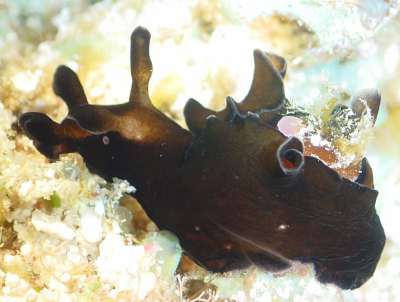Aplysia cf. parvula from Mayotte
December 16, 2003
From: Marina Poddubetskaia


Dear Bill,
Aplysia cf. parvula is also present in Mayotte. But while the typical Aplysia parvula is found in the red alga (see my previous message), these black specimens were seen in the open area, just on the rocks. In fact, I have never seen any dark Aplysia parvula in the red algae, only reddish ones.
In Mayotte I've collected both red and black Aplysia, so I hope one day we will know if they are of the same species.
Bill, please note the small 'garden' on the foramen of the first specimen :-)
Upper Photo 1: November 02, 2003. Location : N'gouja, Mayotte Island, Indian Ocean. Site: Passe Bateau., Depth: 14m., Size: 25mm [also close-up of foramen with algal growth].
Middle Photo: November 05, 2003. Location: Mayotte Island, Indian Ocean., Site: Passe en S, buoy n° 3. Depth: 3.5m., Size: 15mm
Best wishes,
Marina.
nembro@nembro.info
Poddubetskaia, M., 2003 (Dec 16) Aplysia cf. parvula from Mayotte. [Message in] Sea Slug Forum. Australian Museum, Sydney. Available from http://www.seaslugforum.net/find/11666
Dear Marina,
Thanks for these photos. It is interesting that both Scott Johnson [see his earlier message] and I consider this to be a colour form of Aplysia parvula. I realise it's not very scientific, but when you have seen a these animals in the field they certainly mirror the ways of A. parvula. You say that 'typical' A. parvula is always found in red algae. But that is the crux of the problem - What is typical A. parvula?. In fact the question of its food may in fact be the answer. Perhaps these black animals are feeding on an alga which darkens their skin? Both your photos shows traces of a black or bluish-black band around the parapodial edge as found in 'typical' A. parvula. Often in Aplysia cf. parvula the parapodial edge seems white or very pale - and that is emphasised by the very black or dark brown of the rest of the animal - but if you look carefully there are often traces of black pigmentation at the edge. I am pretty sure this is a form of A. parvula but am leaving it on a separate page at present so we can be aware of the differences.
The algal garden reminds me of the similar garden on the shell of the animal in the Haminoea cymbalum Fact Sheet. These opportunistic green algae, such as Enteromorpha, settle and grow very quickly on clean surfaces. They don't last long but by growing quickly they can complete a reproductive cycle before being crowded out by some other organism, either plant or animal. It is unlikely that anything else will replace these green algae on the Aplysia shell because the animal is relatively short-lived.
Best wishes
Bill Rudman
Related messages
-
Aplysia cf parvula from Indonesia
From: Indra Swari, December 7, 2006 -
Aplysia cf. parvula from the Red Sea
From: Oren Lederman, March 22, 2006 -
Aplysia cf parvula from the Red Sea
From: Oren Lederman, May 25, 2005 -
Aplysia cf. parvula from Mauritius
From: Marina Poddubetskaia, November 16, 2002 -
Re: Aplysia cf. parvula (?) from the Red Sea
From: Erwin Koehler, April 7, 2002 -
Aplysia cf. parvula (?) from the Red Sea
From: Dr. Jacob Dafni, March 30, 2002 -
Unknown Aplysia from the Philippines
From: Erwin Koehler, April 25, 1999
